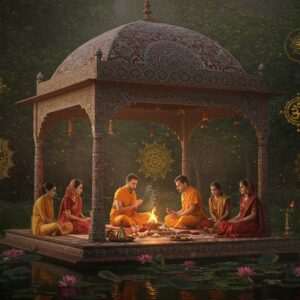Understanding the Grihastha Ashrama: A Guide to the Second Stage of Life

In Hindu philosophy, human life is divided into four stages called ashramas, each with unique duties and objectives. The Grihastha Ashrama, or householder stage, is the second of these, focusing on family, societal responsibilities, and the pursuit of a purposeful life. This stage traditionally begins with marriage and involves building a family, earning a livelihood, and contributing to society.
This stage emphasizes the pursuit of Purushartha, the four aims of human life: Dharma (righteous conduct), Artha (material prosperity), Kama (fulfillment of desires), and Moksha (liberation). For many individuals today, understanding the Grihastha Ashrama can provide a valuable framework for navigating the complexities of modern life while maintaining a connection to tradition.
Are you looking to enhance your understanding of Hindu traditions and practices? Explore our extensive collection of resources and products at poojn.in.
The Significance of Grihastha Ashrama
The Grihastha Ashrama is considered a cornerstone of Hindu society, providing a foundation for both individual growth and societal well-being. It plays a crucial role in maintaining balance among the other ashramas: Brahmacharya (student), Vanaprastha (retirement), and Sannyasa (renunciation). It is through the Grihastha Ashrama that families are formed, traditions are passed down, and society as a whole is sustained.
During this stage, individuals learn to balance their various roles and responsibilities – as spouses, parents, providers, and members of the community. This balancing act helps develop essential life skills like responsibility, compassion, and the ability to manage resources effectively. The Grihastha Ashrama also provides opportunities for spiritual growth, as individuals learn to integrate their worldly duties with their inner spiritual journey.
Dharma and Duty within the Grihastha Ashrama
Dharma, or righteous conduct, takes center stage in the Grihastha Ashrama. It guides individuals in fulfilling their duties and responsibilities with integrity and compassion. These duties extend to various aspects of life:
- Family: Building a strong and loving family is a primary focus. This involves raising children with good values, caring for elders, and maintaining harmonious relationships within the household. It promotes the continuity of family lineage and traditions across generations. It emphasizes the importance of creating a stable and nurturing environment.
- Society: Contributing to society through work, charity, and community involvement is another key aspect of Dharma. Householders generate resources, support those in other ashramas, and participate in activities that benefit the wider community. It reinforces the interconnectedness of individuals within the larger social fabric. It encourages active participation in the community’s growth and well-being.
- Spirituality: While engaging with worldly responsibilities, individuals are also encouraged to maintain their spiritual practices. This can include daily prayers, meditation, participation in religious ceremonies, and studying sacred texts. This spiritual foundation helps guide individuals through the challenges and joys of family life.
Need guidance on setting up your personal puja space? Poojn.in offers a curated selection of altars, idols, and other puja essentials. Visit poojn.in to learn more.
Pooja Essentials for the Grihastha Ashrama from Poojn.in
Maintaining a dedicated puja space and performing regular rituals are important aspects of the Grihastha Ashrama. Poojn.in offers a wide range of products to support your spiritual practices:
- Pure Cow Ghee: Essential for havans, yagyas, and daily puja rituals. Available in convenient sizes. Explore our range of pure cow ghee.
- Pooja Samagri Kits: Comprehensive kits containing all the essential items for performing various pujas. Find the perfect kit for your needs.
- Copper and Brass Items: A selection of beautifully crafted ritual items like diyas, kalash, and thalis. Browse our collection.
Embracing the Grihastha Ashrama Journey
The Grihastha Ashrama is a journey of growth, fulfillment, and contribution. While it presents its share of challenges, it also offers immense opportunities for personal and spiritual development. By embracing the values of Dharma, nurturing family bonds, and contributing to society, individuals can live a meaningful and purposeful life within the Grihastha Ashrama.
Looking for deeper insights into Hindu rituals and traditions? Discover a wealth of information on our blog at poojn.in.
FAQs about Grihastha Ashrama
What defines the Grihastha Ashrama? The Grihastha Ashrama is the second stage of life in Hindu tradition, characterized by the establishment of a household, family life, and the pursuit of societal duties.
What is the significance of this stage? It holds significant importance as it sustains society by producing resources, raising families, and upholding cultural values. It fosters individual growth through the fulfillment of responsibilities and provides a framework for balancing worldly pursuits with spiritual growth.
What role does Dharma play in the Grihastha Ashrama? Dharma is the guiding principle, emphasizing righteous conduct in all aspects of life, from family responsibilities to societal contributions. It encourages individuals to live ethically and contribute positively to the world.
How does one transition into the Grihastha Ashrama? Traditionally, the transition occurs with marriage, marking the beginning of household responsibilities and family life. This transition signifies a shift from the student stage to a life focused on building a family and contributing to society.
Want to create a serene atmosphere for your daily pujas? Explore our wide range of incense sticks and dhoop at poojn.in.


